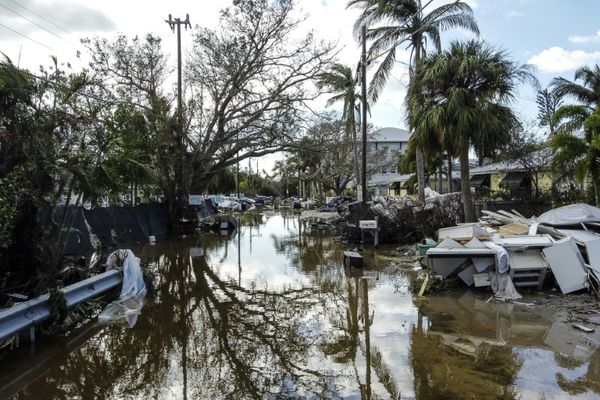
For two Mondays in a row Russia has launched missiles at Kyiv’s city centre, in the most intense strikes on the capital since Moscow launched its full-scale invasion of Ukraine.
The targets of these missiles are unclear – if they were meant to strike crucial infrastructure, the only real clarity is that they have exploded in central, residential districts, falling close to parks, offices and cultural buildings.
Two of last week’s explosions were so close to significant national monuments that some speculated that the statues themselves – sandbagged and protected – might have been the targets.
One of those missiles cratered a children’s playground a few metres from a monument to Taras Shevchenko, Ukraine’s national poet. Fundamental in creating a Ukrainian-language literature, he was exiled by Tsar Nicholas I and banned for writing or making art for a decade. In a neat turn of history, his monument, when it was erected in 1939, replaced an earlier statue of that very same Russian ruler.
Another missile, landing on the other side of the park bearing Shevchenko’s name, hit a road intersection, part of a morning of Russian strikes that killed seven and injured more than 50 in the city. It also scattered hoarding protecting a monument to the statesman and scholar Mykhailo Hrushevsky, a key figure in the pre-revolutionary Ukrainian nationalist movement, and the author of a 10-volume history of the country.

Kyiv’s statues – sandbagged by the city authorities for protection – are one of only a few reminders, along with an 11pm curfew and the regular wailing of air raid sirens, that this bustling city is at war. Boxed up, muffled, veiled and hidden, they also give Kyiv a strange new look – as if the sculptures have been replaced by contemporary artworks.
In Volodymyrska Hirka Park, where paths wind through trees above the Dnieper River, a sculpture dedicated to Dante Alighieri was inaugurated in 2021 – a gesture towards western European, rather than Russian, culture. His gaunt, rather mournful carrara marble head pokes up comically from above the sandbags.
He looks much like Winnie buried up to her neck in Samuel Beckett’s bleakly funny play Happy Days. Indeed, Beckett seems entirely appropriate for the coal-black sense of humour that so many Kyivans are displaying in the face of the Russian invasion.

A few steps away is one of Kyiv’s most controversial Soviet-era sculptural ensembles, unveiled in 1982. Its centrepiece was a statue symbolising Russian-Ukrainian friendship. Over it was erected a huge metal arch commemorating what was termed by the Soviets the “reunification” of Russia and Ukraine in 1654.
Next to the arch was placed a granite sculpture depicting the council of Pereiaslav, at which the Cossack Bohdan Khmelnytsky offered allegiance to Muscovy in return for protection – rather than the “reunification” claimed by the Soviet propaganda.
Unsurprisingly, in April this year, the twin figures symbolising Russia and Ukraine were jubilantly removed – a manoeuvre involving the decapitation of one of the figures – leaving the scarred plinth behind.
The arch, which had already been renamed the Arch of Friendship after the fall of the Soviet Union and in 2018 painted with a large black symbolic crack, was this May given a new title, the Arch of Freedom of the Ukrainian People.

Since then, the granite sculpture of the council of Pereiaslav has been boxed up in a plywood structure that has now aged to a rich grey patina – in this case, the point being not to protect it from Russian missiles but to hide it from public view until it can be dismantled. It would resemble a Rachel Whiteread sculpture were it not for the Ukrainian flag that someone has painted on the side.
Nearby, Saint Volodymyr, who made Christianity the official religion of Kyivan Rus at the turn of the first millennium CE, is still visible, brandishing his cross over the Dnieper below. Only his elaborated carved plinth is protected. But his redoubtable grandmother Olha, a Kyivan ruler who outwitted her various enemies to keep control of the nascent city in the 10th century, has been thoroughly sandbagged in Mykhailivska Square.

Currently, the monument has a touch of Anselm Kiefer about it. Protest banners are draped over it, plants are already sprouting from the sandbags, and beside it burnt-out Russian tanks and other captured vehicles are on display, carefully labelled by the Ukraine’s national military history museum.
In the neighbouring Sophia Square, there is a similar juxtaposition of old and new. The top of Bohdan Khmelnytsky’s head can just be seen poking out above boards and scaffold, bundled up in green fabric secured with red binding.

Attracting more attention, though, is a new memorial, which soldiers installed on Thursday afternoon. By Friday, the simple display of large photographs of Azov battalion soldiers killed at the siege of Mariupol was already a scene of pilgrimage, with visitors entwining the memorial with sunflowers and other offerings.
One Kyiv public sculpture that is neither sandbagged nor boxed up, and lacks protection of any kind, is the imposing equestrian statue dedicated to Mykola Shchors. The Ukrainian officer fought in the Red Army against the independent Ukrainian People’s Republic that was briefly established between 1917 and 1920.

The statue is daubed with graffiti, translating to slogans such as “demolish me completely!” and “butcher”. There are plenty of people in Kyiv who would not mind at all if one of Vladimir Putin’s missiles happened to hit that one.







